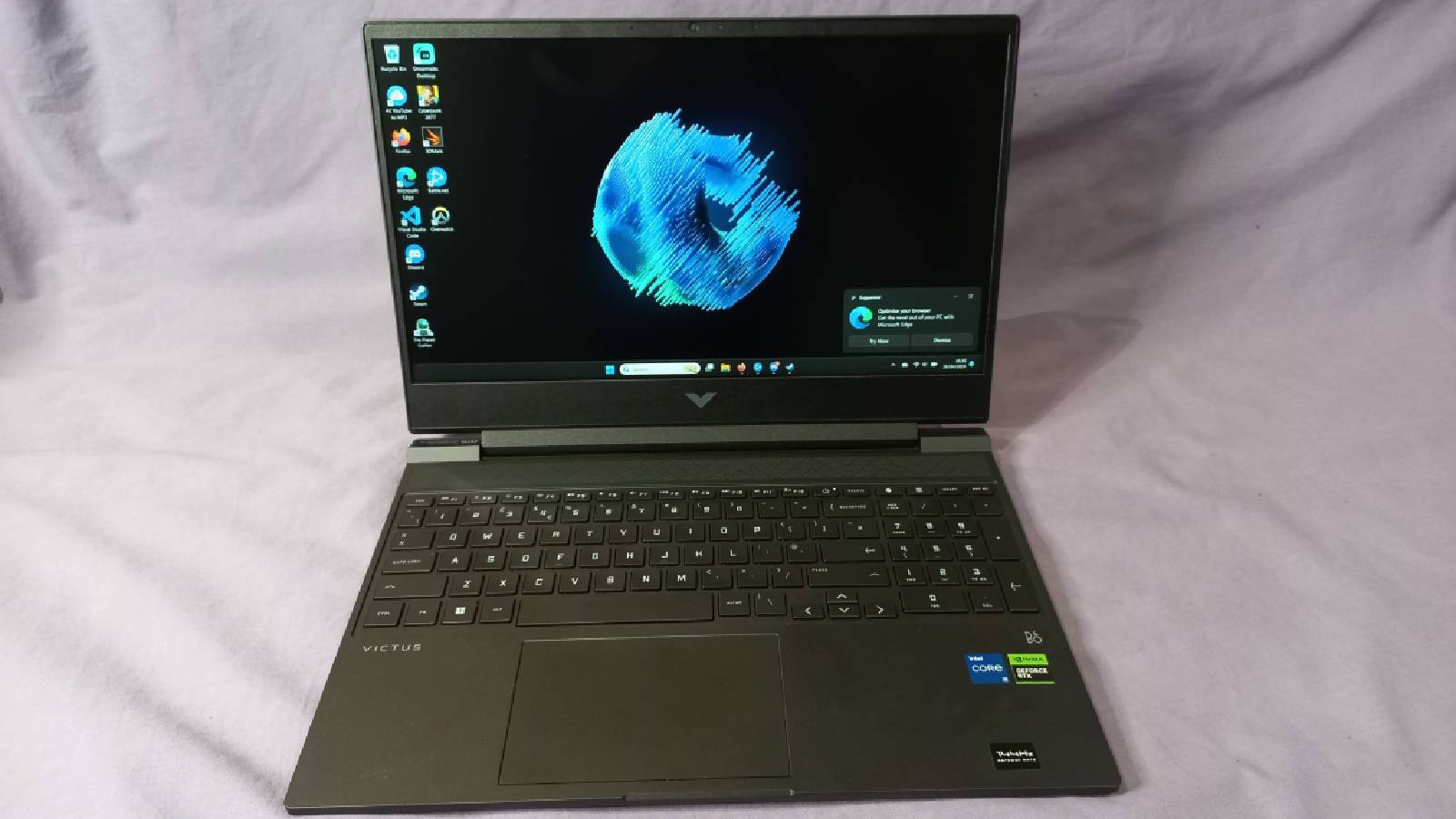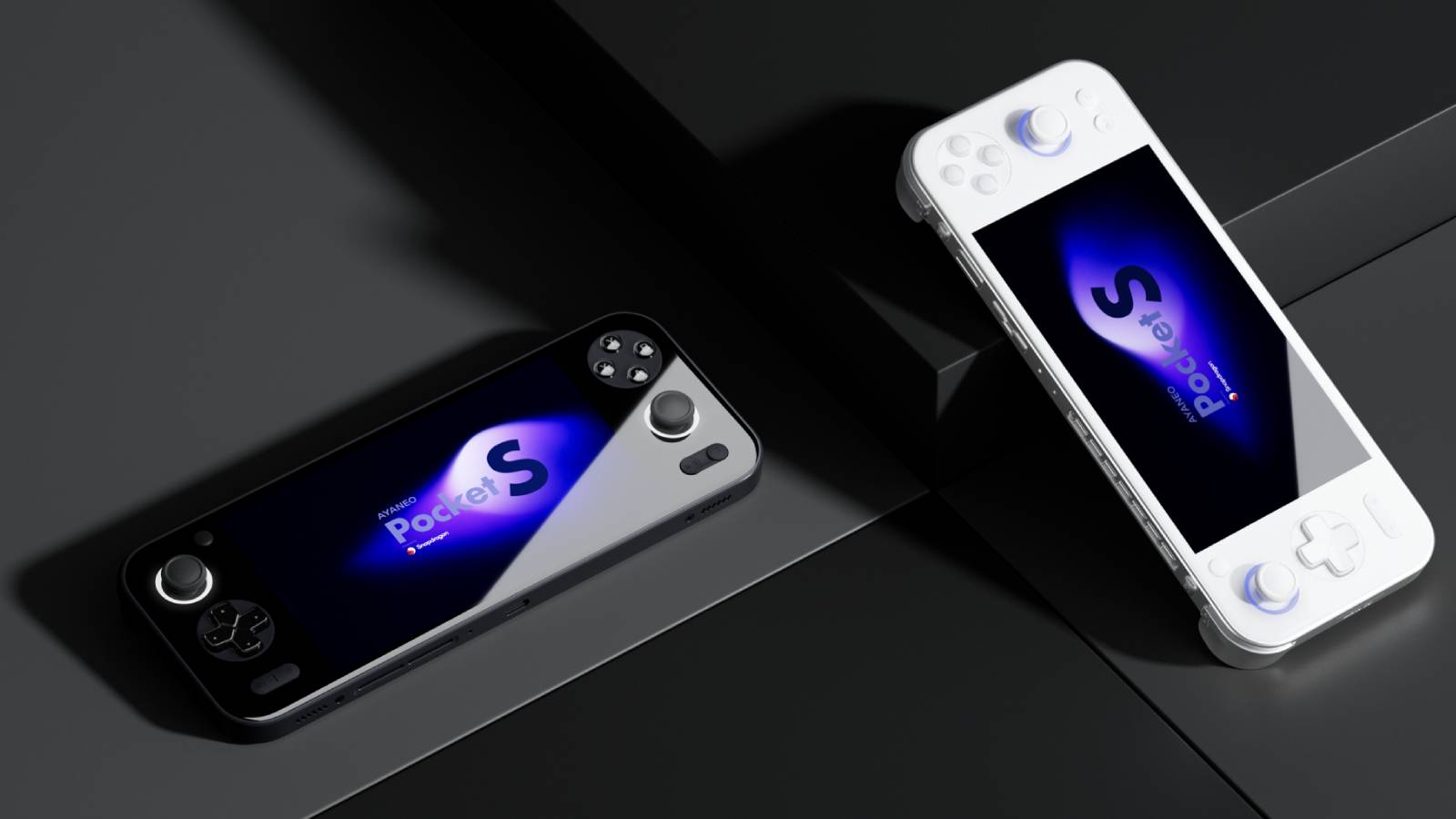Asus ROG Strix Scar 17 X3D review: Ryzen ravages the competition
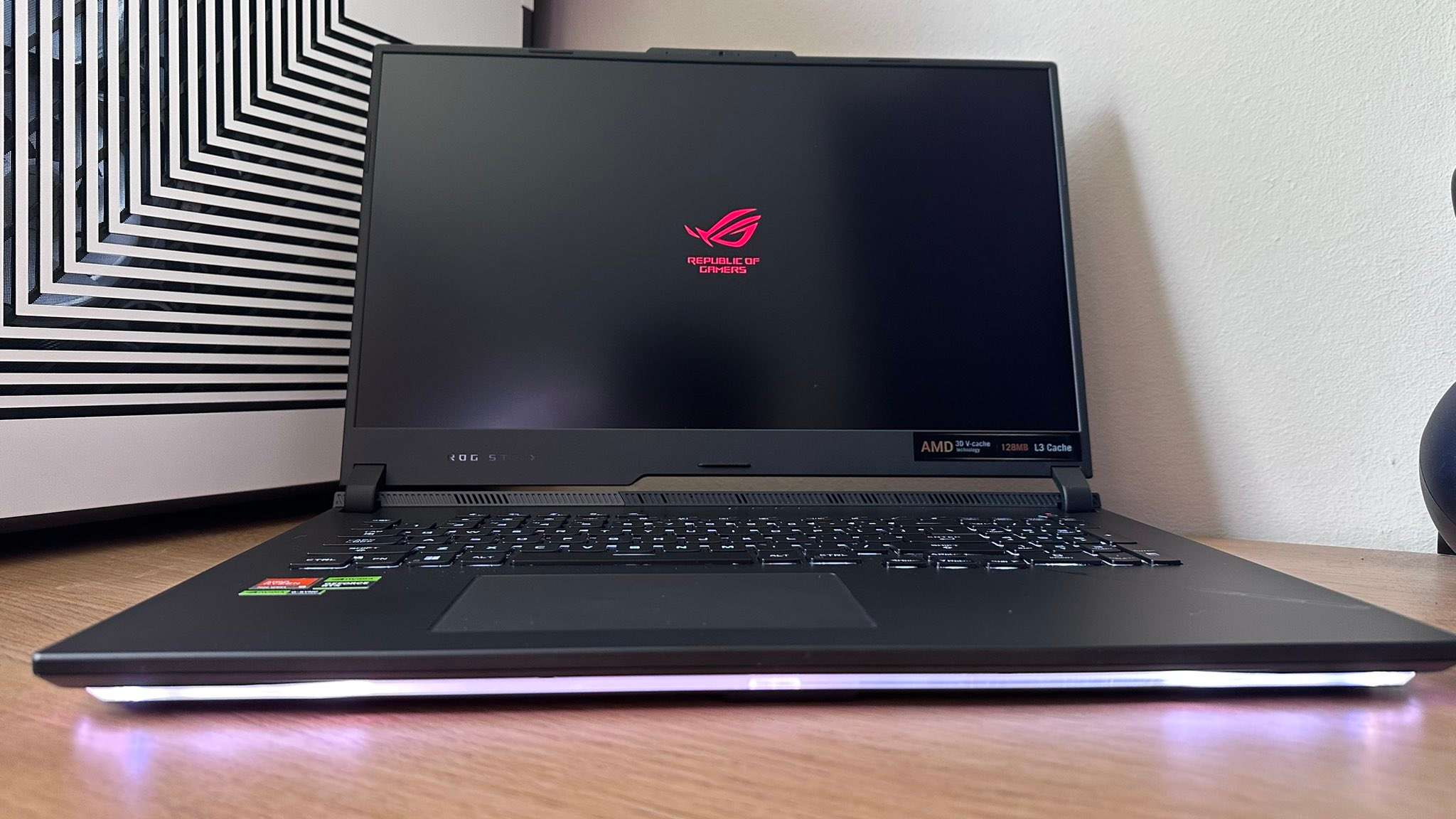 Dexerto
Dexerto Asus’ ROG Strix Scar 17 comes fully equipped with a brand-new high-end Ryzen 7945HX3D chip, but does it stand tall versus other gaming laptops?
The Asus ROG Strix Scar 17 X3D is a huge gaming laptop, not only does the device possess a gargantuan chassis, but it also has the specs to match. While the device remains relatively thin, it’s supremely powerful. Sporting the brand-new AMD Ryzen 7945HX3D chip, this laptop is the first in the world to make use of AMD’s fantastic 3D V-Cache technology in a portable form factor.
We’ve had some time to test the ROG Strix Scar 17 3D, and we’re finally ready to spill all the details with everything you need to know including performance benchmarks.
Key specs
- CPU: AMD Ryzen 9 7945HX3D (16 core, 32 thread, up to 5.4GHz, 128MB L3 cache)
- RAM: 32GB DDR5-4800MHz
- GPU: Nvidia GeForce RTX 4090 (16GB GDDR6, 175W)
- Display: 17-inch 16:9 LCD (WQHD 240Hz)
- Battery: 68.1 Whr (230W power adapter)
- Storage: 1TB PCIe 4.0 NVMe SSD
- Operating System: Windows 11 Home
- IO: 2x USB 3.2 Gen1 Type-A, 2x USB 3.2 Gen 2 Type-C ports, 1x HDMI 2.1 FRL, 3.5mm combo jack, LAN port
- Weight: 3.0KG
- Features: Liquid metal vapor chamber cooling, 225W max power draw, Dolby Atmos speakers
- Price: £3,799.99
Design
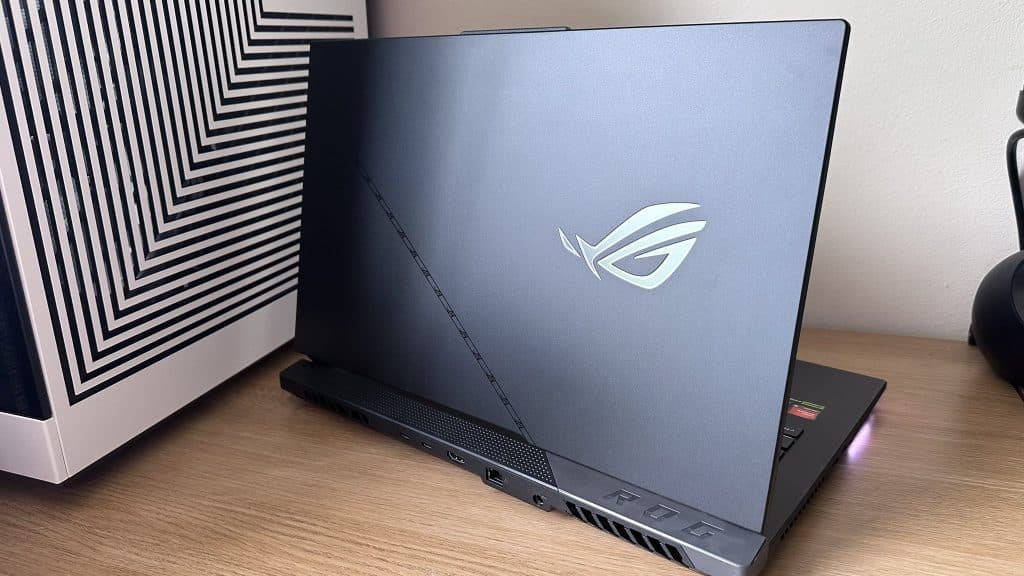 Dexerto
Dexerto The ROG Strix Scar 17 X3D might not have a fancy all-metal shell like the Razer Blade lineup, but what it does possess is raw, unmitigated power inside of its relatively slim 3kg chassis. The black plastic finish of the device is littered with ROG motifs, and logos at the top, which glow when the device is turned on. The rear portion of the laptop also houses its IO and power, with scant few USB ports flanking the sides. we prefer this look, as it makes the laptop appear much cleaner on your desk, and could help with cable management, too.
From the underside, to each of the device’s sides, there’s plenty of space for air ventilation on the chassis, too. On the underside, you also have two RGB strips that illuminate your desk for that signature ROG look. We’re not huge fans of RGB sucking away precious battery life on mobile devices, but if you swing that way, you can also turn it off within software.
Opening the ROG Strix Scar 17 X3D presents you with a modest trackpad, which felt great to use throughout the duration of our testing. While it might not match the gold standard of Razer or Apple, it’s still more than suitable for use while operating the system as a workstation or portable battlestation.
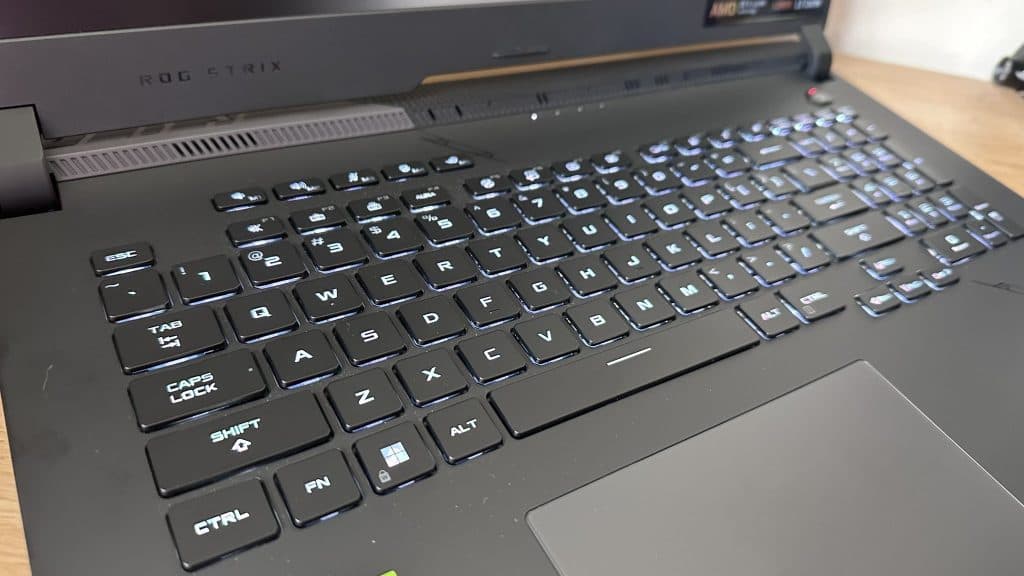 Dexerto
Dexerto The screen is huge, and is G-Sync compatible, with a 3ms response time. Its WQHD resolution is perfect for the size, and always makes content look incredibly sharp, to boot. With an up to 240Hz refresh rate, this panel is perfect for the power that’s packed inside, as many games will actually reach those triple-digit figures at native resolution.
The keyboard here is nothing to write home about, with a standard chiclet layout and “gamer-y” legending. We do appreciate the fully-sized nature of the keyboard, with a full function key layout, and extra media keys to boot.
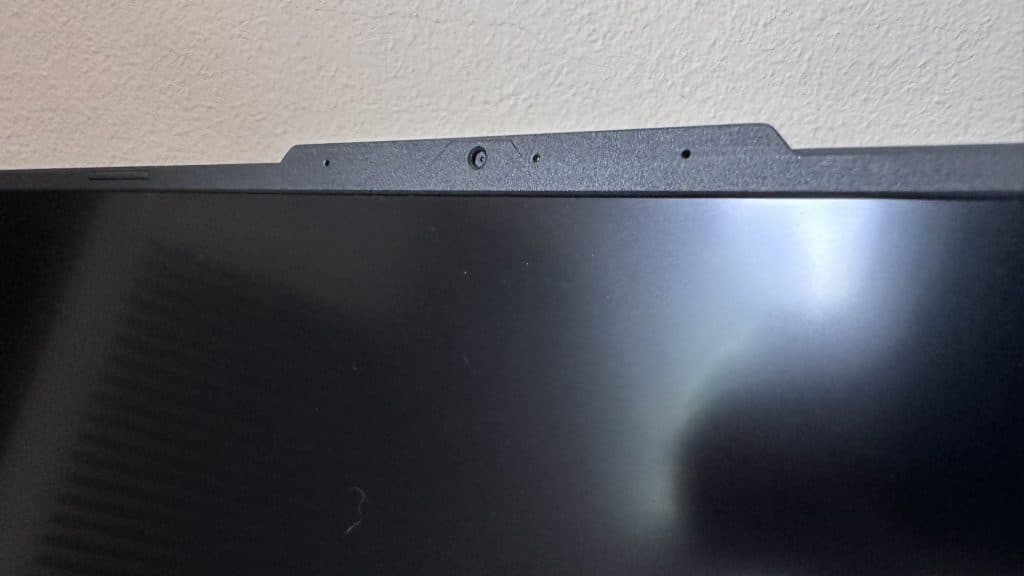 Dexerto
Dexerto We were less impressed by the 720p webcam. At this price, we would expect a slightly higher-quality sensor that’s on offer here, and it ends up being nothing more than serviceable. Meanwhile, the Dolby Atmos speakers housed within sound fantastic while playing games, and while headphones are an obvious recommendation, they sound fantastic.
Internal components
The ROG Strix Scar 17 X3D boasts the most powerful laptop chips to come to market, an RTX 4090 mobile, which possesses 16GB of RAM that can drink up to 175W of power, in addition to the brand new Ryzen 9 7945HX3D.
The Ryzen 9 7945HX3D might be a mouthful, but it possesses some of the most impressive specs on a mobile laptop’s chipset we’ve ever seen. We have previously talked about how great AMD’s 3D V-cache is for boosting framerates in games, and in our testing, we’ve observed that the 128MB L3 cache within the device manages to bring its power to new heights. Thanks to Nvidia Optimus, you can also automatically switch to the built-in RDNA2 graphics when not using the massive 4090, which is also a boon for lighter load scenarios.
There are some concessions here like the meager 1TB of storage onboard, but you can configure this to be higher.
Performance
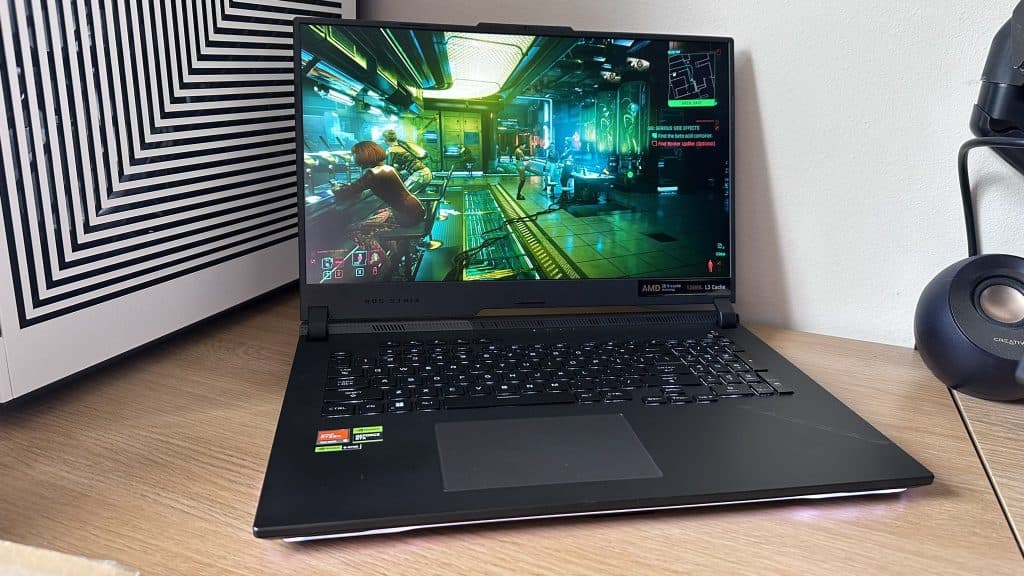 Dexerto
Dexerto The ROG Strix Scar 17 X3D is the fastest gaming laptop we have ever tested. It handily beats the flagship Intel CPUs, while also remaining supremely power efficient at 55W. Thanks to the device’s screen boasting a 2560×1440 panel, we’ve based our testing at 4K and 1440p resolutions. While it’s unlikely that you’ll be playing many titles at 4K, it’s a good showcase of what the device can offer, with its 3D V-cache.
We plugged the laptop in for all results, allowing us to access the full power profile of the laptop itself. We’ve also compared it against our test system, so you can get an apples-to-apples comparison with desktop-level performance, too.
Test System
- CPU: Intel Core i5-13600K
- CPU cooler: Cooler Master PL360 Flux
- Motherboard: ASUS ROG Z790 Maximus Extreme
- RAM: ADATA XPG Lancer RGB 32GB DDR5-6000
- Storage: Sabrent Rocket 4 Plus 4TB
- Case: Hyte Y60
- PSU: EVGA Supernova GT 1300
Synthetic benchmarks
| 3DMark | Asus ROG Strix Scar 17 X3D (4090 / 7945HX3D) | Razer Blade 16 (4090 / 13950HX) | Razer Blade 14 (4070 / 7940HS) | RTX 4070 Ti / 13600K (Desktop) |
| Time Spy Extreme | 9741 | 9279 | 5595 | 11274 |
| Port Royal | 12305 | 11980 | 7262 | 14482 |
| Speed Way | 5175 | 4951 | 2902 | 4520 |
In 3DMark’s synthetic benchmark suite, the X3D-equipped laptop blasts through almost every other gaming laptop we have tested. The only system to come close to this level of performance is the Razer Blade 16, which is equipped with Intel’s 13950HX processor, which is around 3% slower with regard to synthetic performance. However, the 13950HX’s power draw is much higher, making the 7945HX3D a much more efficient chip overall.
ROG Strix Scar 17 X3D 4K gaming performance
| Game | Asus ROG Strix Scar 17 X3D (4090 / 7945HX3D) | Razer Blade 16 (4090 / 13950HX) | RTX 4070 Ti / 13600K (Desktop) |
| Forza Horizon 5 (Ultra) | 126 FPS | 115 FPS | 123 FPS |
| Cyberpunk 2077 (Ultra, RT Ultra, DLSS Performance, Frame Generation / FSR ) | 78 FPS | 68 FPS | 89 FPS |
| Cyberpunk 2077 (Ultra, RT Ultra, DLSS off) | 19 FPS | 16 FPS | 29 FPS |
| CS:GO (High, Dust 2) | 257 FPS | 194 FPS | 264 FPS |
| Overwatch 2 (Ultra) | 268 FPS | – | 272 FPS |
At 4K, the ROG Strix Scar is around 15% faster than the Blade 16, which is no slouch. We have omitted our Blade 16 Overwatch 2 test result here, as the result was erroneous, and we no longer have access to retest the system. Regardless, the Strix Scar manages to put in an impressive performance here. You can expect to push the display’s limits in competitive esports titles at high resolutions.
The laptop also stands up well against our testbench system equipped with an RTX 4070 Ti, showcasing just how powerful these parts are, and how much performance you can really get out of a gaming laptop that’s packed to the gills with speedy hardware in 2023.
ROG Strix Scar 17 X3D 1440p gaming performance
| Game | Asus ROG Strix Scar 17 X3D (4090 / 7945HX3D) | Razer Blade 16 (4090 / 13950HX) | RTX 4070 Ti / 13600K (Desktop) |
| Forza Horizon 5 (Ultra) | 129 FPS | 107 FPS | 147 FPS |
| Cyberpunk 2077 (Ultra, RT Ultra, DLSS Performance, Frame Generation / FSR ) | 121 FPS | 126 FPS | 161 FPS |
| Cyberpunk 2077 (Ultra, RT Ultra, DLSS off) | 39 FPS | 38 FPS | 47 FPS |
| CS:GO (High, Dust 2) | 384 FPS | 275 FPS | 454 FPS |
| Overwatch 2 (Ultra) | 362 FPS | 344 FPS | 404 FPS |
At 1440p, the ROG Strix Scar 17 X3D’s native resolution, the laptop blazes past the competition with utter ferocity. Again we see around a 15% difference in performance when compared to the Blade 16, while the desktop-class 4070 Ti just manages to edge out the laptop in some benchmarks.
In particular, performance in titles that push the CPU at high framerates, like CS:GO show that the Ryzen system has a slight advantage against its Intel counterpart.
Thermal performance
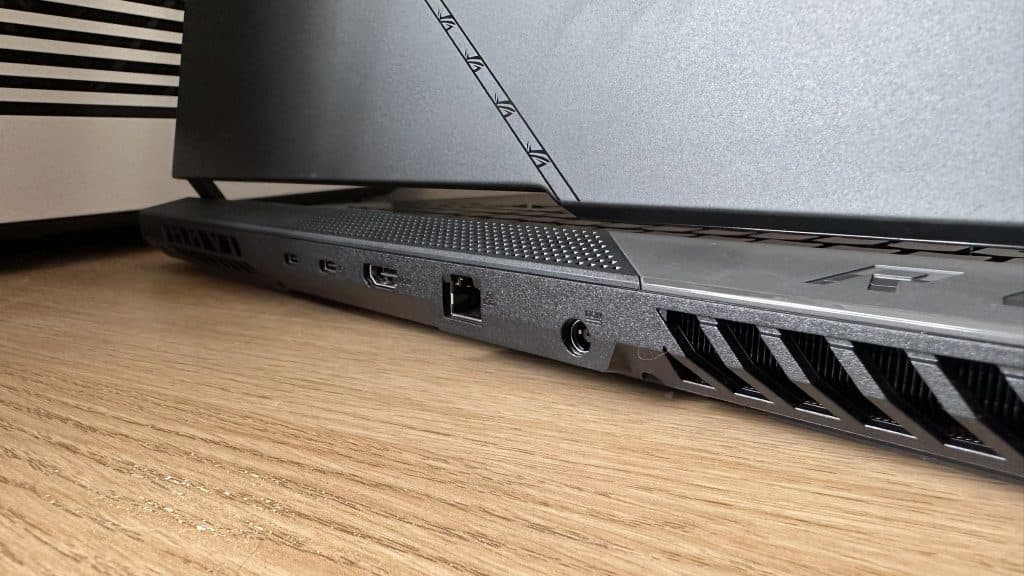 Dexerto
Dexerto The thermal performance of the ROG Strix Scar 17 X3D is impressive. Despite coming in at just 3kg, the laptop manages to cool its components very well. We saw peaks of 91 degrees on the CPU, while the GPU sailed by at 83 degrees. This is much better compared to the Razer Blade 16, which could reach around 100 degrees internally.
You can configure fan settings through the device’s included software, and of course, when the fans spin up, you can expect things to get pretty loud. We measured the device reaching just over 46db, and recommend that you play any games using a nice pair of headphones or earbuds in order to mitigate this. Of course, when pushing the chip to its limits, you have to also consider battery life.
Battery life
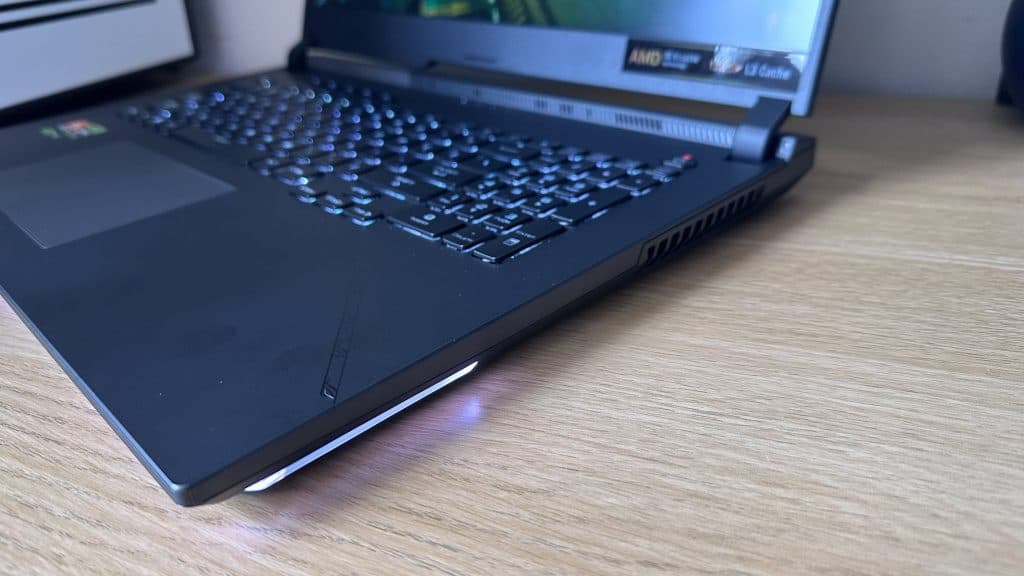 Dexerto
Dexerto In a full gaming session of Baldur’s Gate 3 on the system, we managed to get around 3 hours of gaming out of the system before having to reach for the power plug. Setting your display refresh rate lower does help somewhat, however. When we switched to using GeForce Now to play Baldur’s Gate 3, which is essentially just video playback, we attained around four and a half hours of battery life before once again having to reach for the charger.
The 4090 within sucks up a ton of battery, and while the CPU remains incredibly efficient, powering a behemoth of a laptop like this still means that gaming on the go is limited to short bursts only.
Should you buy it?
If you’re looking for a desktop-replacement style system, the ROG Strix Scar 17 X3D is as fast as it gets. It goes toe-to-toe with even high-end desktop PCs, and manages to blow every single other gaming laptop out of the water when it comes to performance. We loved testing titles using the buttery smooth display, and with the latest tech housed inside, the laptop manages to become more than the sum of its parts. The ROG Strix Scar is incredibly expensive, but compressing all that power into a small package has to come at a price.
The Verdict: 4/5
The ROG Strix Scar 17 X3D is the fastest gaming laptop on the planet. For the price, you get outstanding performance when compared to even the fastest gaming laptops. We just wished that some trimmings like its overly “gamer-y” branding were toned down. But, otherwise, this laptop might be a great solution for those wanting a battlestation to take between multiple locations. It lacks some of the features of the Blade 16, like the dual-mode display too. But, where it counts, the ROG Strix Scar 17 X3D has an unbelievable amount of power considering its size.
If you click on a product link on this page we may earn a small affiliate commission.
